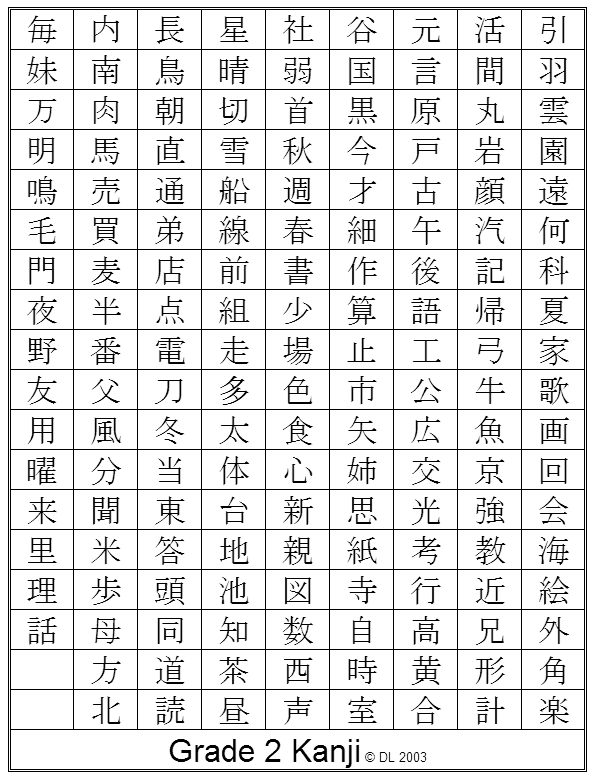Most people don't have any interest in learning Japanese which I completely understand (sometimes I wish I wasn't interested in it either haha) but I figure I would make an attempt to explain some of the neat features that Japanese has. I might also clear up some common language misconceptions in the process.
1. Japanese is not a tonal language. You are thinking of Chinese. A tonal language is one where the majority of sounds in the language have multiple tones and by changing the tones you can completely change the meaning of the word. Japanese and Chinese are almost as different from each other as Japanese and English are in terms of both grammar and sound.
2. Japanese pronunciation is arguably the easiest of any major language in the world. It is also one of the first neat features about the language. Take a look at the following chart (you should be able click the image to enlarge it):
This chart is written in one of the Japanese "alphabets" (Japanese has 3 "alphabets" but we will get to that in a moment) with the corresponding English equivalent. Notice anything unusual?
Well for starters this represents essentially all of the possible sounds (technically called "mora's" in Japanese) possible in the entire language. English only has 26 letters in its alphabet so you might be thinking "So what?". What you have to understand is that each letter of the English alphabet represents essentially the smallest measurable unit of sound possible but that these consonants and vowels can be arranged in all kinds of different ways to create tons of different syllables and sounds.. In Japanese there is only one lone consonant sound in the entire language (the "n" sound)! As you can see the simplest letter of the Japanese alphabet is in fact either a vowel or what would basically be considered an entire syllable in English and they are ALL vowel ending! So what you have to realize is that to a Japanese person there is no lone "K" sound. There is ONLY the "Ka, Ki, Ku, Ke, or Ko" sounds. Also, if the Japanese "Ka" character is written it is pronounced "Ka" no matter where it is in a word. Other characters don't have an effect on the character's pronunciation around them like they do in English.
Furthermore, Japanese is generally supposed to be spoken with "mora timing" which means you are supposed to give the exact same timing for every "letter".. So what this all basically means is that Japanese is spoken as a near endless stream of "perfect" consonant+vowel syllables (or more technically mora's).
3. Reading Japanese really is as hard as it is claimed to be but probably for a different reason than you think. The Foreign Service Institute of the U.S. Department of State considers Japanese to be the most difficult language in it's 63 language high intensity full immersion language programs specifically due to the difficulty of the reading/writing system. So why is that? The answer is simple: Kanji.
If you read the above I mentioned that Japanese has essentially three "alphabets". Two of the alphabets are exactly the same in terms of the sounds they represent. English has this same feature with upper and lower case letters although the uses are a bit different. One "case" of the Japanese alphabet is used for grammar points within a sentence and some Japanese words where as the other "case" is used primarily for foreign words that have been put into Japanese (for example if they want to write McDonald's using just Japanese they can do so using only Japanese characters).
But the real devil is Kanji which is used in sentences in combination with the other alphabets. Kanji are the crazy looking characters that Japan and China both use. Example:
So how do Kanji work? Well each Kanji by itself has a general idea or meaning behind it and many Kanji by themselves are in fact single words on their own. However, Kanji can also be combined with other Kanji to form new words and in fact the vast majority of the words in Japanese and Chinese are combinations of Kanji. So naturally the big problem is that there are thousands of Kanji that you need to know right? Yes this is correct and this is the most often cited "crazy" thing about Kanji. Unfortunately that isn't the hardest part.
Japanese Kanji have a devilish surprise that when you first learn about it really can be the breaking point for saying "screw this, I'm learning another language". After nearly 3 years of study I still have to sit back and just laugh at it sometimes. So what is the surprise? Answer: Almost all of the several thousand common Japanese Kanji have multiple pronunciations with essentially no rules as to how they are used.
In Chinese when you learn a character and the pronunciation that is how that character is going to be pronounced no matter where you see it with rare exception. If you see a new word in Chinese that is made of individual characters you already know then congrats, you'll most likely be able to pronounce it.
In Japanese....no such luck. Let me show the insanity that is Japanese:
The following is the Kanji for tree:
Simple right? Heck it even sort of looks like a tree. This Kanji on its own is simply red as "Ki". So then you are walking down the street and you see a sign that has this same Kanji beside the Kanji for "leaf". Now instead of being pronounced "Ki" it is pronounced "Ko". But then you read a little more on the sign and the same tree Kanji pops up again, this time right beside the Kanji for "line". The tree Kanji is now pronounced "Mo". But then the next word you see it in is pronounced "Gi". The next? "Boku". The word after that? "Moku". Or how about "Bi"? Yes, all of the above are the possible pronunciations that the single Kanji for "tree" can have just based on the word that it happens to be in. Even better is that there are hundreds of completely different Kanji that can also have those pronunciations as well.
So what does this mean? Answer: You have to learn almost every combination of Kanji as even if you know every single Kanji and every possible pronunciation that every single Kanji can have you will still just be guessing at the pronunciation for any new combination you encounter even if it contains characters you already "know".
So the next time you tell someone the myth that "English is hard, because we have words like 'read' and 'red" that can be pronounced the same" please know that it is just a huge myth. Japanese Kanji is the read/red problem multiplied by a factor of 100.
Ok now that we've got the syllable type speech and have covered the writing system let's see it in action. The following is a very old Japanese lullaby with Japanese subtitles. For each of the simplest "alphabet" characters, with the exception of the vowels and the solo "n", you'll be able to see and hear how there is no other lone constant sound that exists in the entire language. It is all just perfectly spaced mora's (aka basically syllables) one after another as that is as simple as the sounds can get in Japanese. The only other thing to notice is that there are a few Kanji in the video but the "alphabet" has been written above them in smaller characters. There are a few times when it looks like multiple characters light up for just one sound but this is for special mora timing (for example if there needs to be a one mora timing space a certain character is written smaller than usual before the next character but I don't feel like explaining all of the details regarding that right now haha).
4. Japanese sentence structure and word order. Japanese verbs come last and in fact the only thing necessary to make a "correct" Japanese sentence is a verb. To a native English speaker this makes most Japanese sentences completely "backwards" to us. As an example here is a sentence in Japanese (just written in English phonetics, and with spaces to make it easier as real Japanese has no spaces) plus the English translation in literal word for word order as it matches up to the Japanese words above it. After that I provided a slightly more natural translation. I've numbered each word/phrase as some single "words" in Japanese would correspond to a phrase in English.
Japanese: 1-watashi 2-wa 3-kuruma 4-de 5-mise 6-ni 7-ikimashita
English: 1-Me/I 2-as for 3-car 4-by way of 5-store 6-to 7-went
Or more natural: As for me I went to the store by way of car. (Aka: I used the car to go to the store)
So as you can see you have to get your brain thinking in a nearly completely different order to understand Japanese.
5. Politeness levels. This is one of the other very unique features of Japanese. Japanese speech changes depending on your relative position to the person whom with you are speaking with. Nouns can completely change, prefixes can be added, and verbs are conjugated differently.. There are also many different levels of politeness.
For example if I'm talking to my friends and want to say I don't understand something I can simply say "Wakaranai". However, if I say "Wakaranai" to my teacher when she asks me a question, or to a person that I just met, I've just been rude. To these people I would need to change to the polite form of "don't understand" which is "Wakarimasen". Or if I'm talking about someone's mother I would use a different noun for the word "mother" than if I was talking about my own mother. Or if you want to really insult someone in Japanese all you have to do is drop down to the most impolite form of the word "you" of which there are at least 4 that I can think of right off the top of my head.
6. Japanese slang is awesome but for a very good reason.......there is tons of it. Why? The Japanese verb. With English slang is mainly comprised from the creative use of existing words but this is something many other languages do including Japanese. The Japanese verb is very powerful as a large part of the information in the Japanese language information is conveyed through its verb conjugations. Japanese sentences often don't even bother to include a subject, and in fact are quite famous for it, as the verb is often powerful enough to deliver the context and "direction" of something without explicitly having to state who or what.
Because of this every verb in Japanese has all kinds of crazy slang conjugations that can be made! So not only can you use "normal" slang through creative use of Japanese nouns you can also instantly "slang up" any sentence you want by conjugating the verb into whatever verb "tail" has been made popular at the time.. This video does a better job at explaining things so just watch:
7. Men and women speak differently. I'm not talking about voice pitch either. In Japanese there are actual words and sentence endings that are exclusive to each sex. This is something you actually have to be careful of when learning the language as learning exclusively from women will have you sounding like a woman regardless if your voice is as deep as James Earl Jones.
Well I think that should be enough for now.......if you even made it this far haha.







